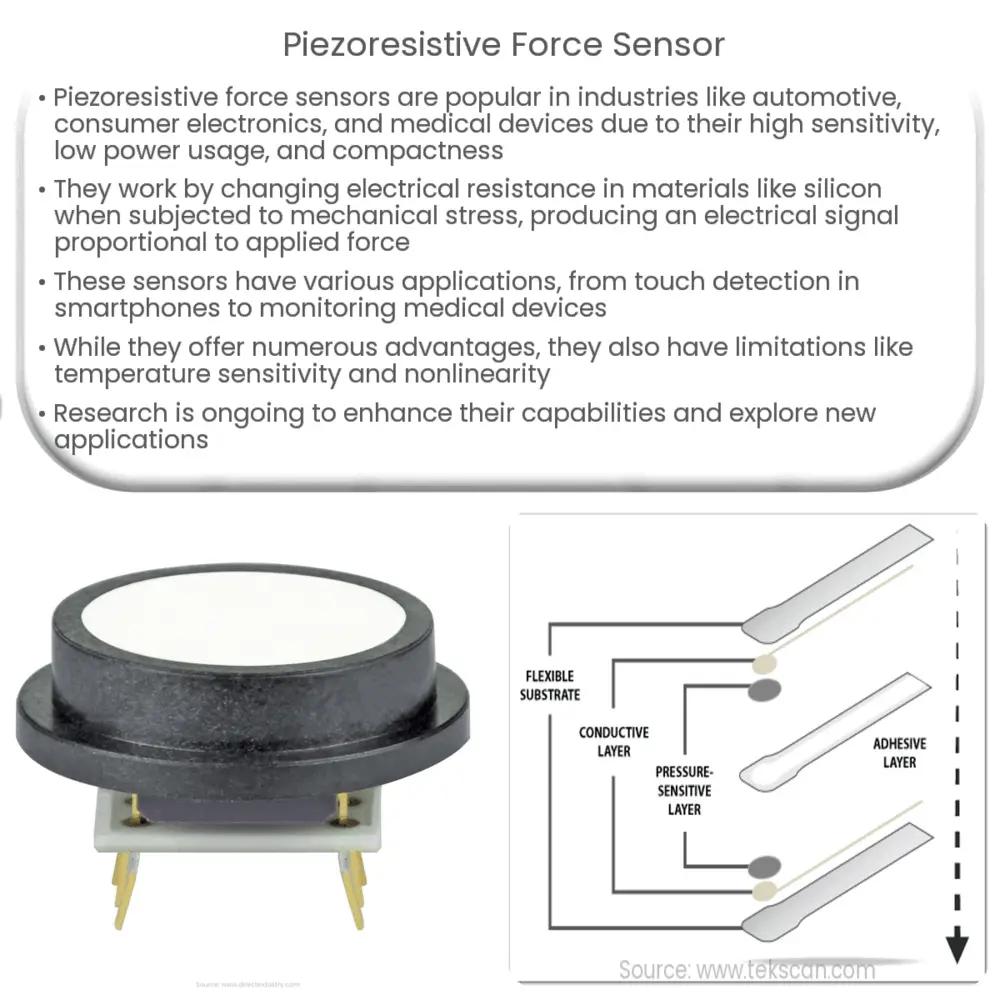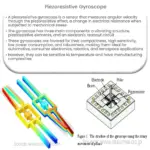Piezoresistive force sensors are compact, sensitive devices that measure force by detecting changes in electrical resistance in response to stress.

Piezoresistive Force Sensors: An Overview
Introduction
Piezoresistive force sensors have become increasingly popular in various industries, including automotive, consumer electronics, and medical devices, thanks to their high sensitivity, low power consumption, and compact design. This article provides a comprehensive overview of piezoresistive force sensors, exploring their working principles, applications, and advantages over other sensor technologies.
Working Principle of Piezoresistive Force Sensors
Piezoresistive force sensors are based on the piezoresistive effect, a phenomenon that causes a change in the electrical resistance of certain materials when subjected to mechanical stress. Typically, these sensors employ semiconductor materials such as silicon or germanium, which exhibit a strong piezoresistive effect.
The basic structure of a piezoresistive force sensor consists of a thin, flexible diaphragm that deforms under applied force. This diaphragm is embedded with piezoresistors, which are connected in a Wheatstone bridge configuration. As force is applied to the diaphragm, the resulting deformation causes a change in the resistance of the piezoresistors, leading to an unbalanced Wheatstone bridge. This imbalance generates an electrical output signal proportional to the applied force, which can then be measured and processed.
Applications of Piezoresistive Force Sensors
Piezoresistive force sensors have found a wide range of applications across different industries. Some of the most common use cases include:
- Automotive: In the automotive industry, piezoresistive force sensors are used for various purposes, such as measuring tire pressure, monitoring suspension systems, and detecting collisions for airbag deployment.
- Consumer Electronics: These sensors are found in devices like smartphones, tablets, and wearable gadgets to detect touch input, measure applied force, and monitor user interaction.
- Medical Devices: Piezoresistive force sensors play a crucial role in medical devices, including blood pressure monitors, respiratory devices, and infusion pumps, where precise force measurement is essential for accurate diagnosis and treatment.
- Industrial Automation: In manufacturing and automation processes, piezoresistive force sensors are used for detecting and measuring forces in robotic arms, grippers, and other automated equipment.
Advantages of Piezoresistive Force Sensors
There are several advantages to using piezoresistive force sensors over other sensing technologies, including:
- High Sensitivity: These sensors can detect minute changes in force, making them suitable for applications requiring high-resolution force measurement.
- Low Power Consumption: Due to their inherent low power requirements, piezoresistive force sensors are ideal for battery-powered and energy-efficient applications.
- Compact Design: The small size and thin profile of piezoresistive force sensors allow for easy integration into space-constrained environments.
- Wide Measurement Range: These sensors can measure forces over a wide range, from a few millinewtons to several kilonewtons, depending on the specific sensor design and application requirements.
Challenges and Limitations of Piezoresistive Force Sensors
Despite their numerous advantages, piezoresistive force sensors also face certain challenges and limitations, which include:
- Temperature Sensitivity: The piezoresistive effect is temperature-dependent, which can lead to measurement errors if not compensated for. However, advanced signal processing techniques and temperature compensation circuits can help mitigate this issue.
- Nonlinearity: Piezoresistive force sensors may exhibit nonlinearity in their output response, particularly at higher force levels. This can be addressed through calibration and the use of advanced signal processing algorithms.
- Long-term Stability: Over time, the properties of piezoresistive materials may change, leading to drift in the sensor output. Periodic recalibration is typically required to ensure accurate force measurements over the sensor’s lifetime.
Future Developments and Trends
As the demand for piezoresistive force sensors continues to grow, ongoing research and development efforts aim to address their limitations and explore new applications. Some key trends and developments in the field include:
- Material Innovations: Researchers are exploring new materials with improved piezoresistive properties, such as nanocomposites and advanced polymers, to enhance the performance of force sensors.
- Flexible and Stretchable Sensors: Developments in flexible electronics have paved the way for the creation of stretchable and conformable piezoresistive force sensors, which can be integrated into wearable devices, soft robotics, and biomedical applications.
- Internet of Things (IoT) Integration: As IoT adoption expands, there is a growing need for low-power, compact, and reliable force sensors. Piezoresistive force sensors are well-suited for IoT applications, and their integration is expected to increase in the coming years.
- Artificial Intelligence (AI) and Machine Learning: The combination of piezoresistive force sensors with AI and machine learning algorithms can lead to advanced sensing systems capable of adaptive self-calibration, improved accuracy, and real-time data analysis.
Conclusion
Piezoresistive force sensors have emerged as a versatile and efficient solution for force measurement in various industries, offering numerous advantages such as high sensitivity, low power consumption, and compact design. Although certain challenges and limitations remain, ongoing research and development efforts aim to address these issues and explore new applications. As material innovations, flexible electronics, IoT integration, and AI-driven sensing systems continue to advance, piezoresistive force sensors are expected to play an increasingly important role in a wide range of applications and industries.



